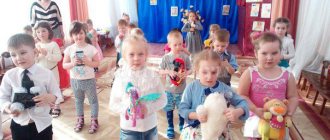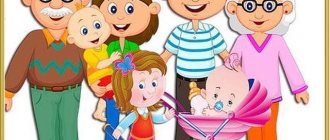Game workshop for parents of a nursery group of a kindergarten
Game workshop for parents of a nursery group: “Journey to the Land of Sensorics.”
Author Svetlana Vasilievna Nazarenko Teacher of MBDOU No. 72 “Dolphin”.
The material presented in this article will be useful to teachers of nursery and junior groups when preparing parent-teacher meetings.
Goal: Enriching parental ideas about the sensory development of toddlers. Objectives : to introduce parents to games that promote the sensory development of children 2-3 years old; strengthen cooperation between parents and the teaching staff of the group. Dear parents! Today I would like to introduce you to the methods and techniques that we use to develop sensory culture in children. But first, a little theory. The sensory development of a child is the development of his perception and the formation of ideas about the external properties of objects: their shape, color, size, position in space, as well as smell, taste, etc. Sensory development, on the one hand, forms the foundation of the child’s general mental development, on the other hand, it has independent significance, since full perception is necessary for the successful education of a child in kindergarten, at school, and for other types of work. Knowledge begins with the perception of objects and phenomena of the surrounding world. All other forms of cognition - thinking, memorization, imagination - are built on the basis of images of perception. Therefore, normal mental development is impossible without relying on full perception. If we look at the main areas in preschool education, then in each of them it is necessary to use knowledge about surrounding subjects. So, for example, in visual activity, in order to draw an object, a child must quite accurately grasp the features of its shape and color. When we walk outside as children, we observe natural phenomena: we talk about the color of the sky, leaves, grass, and what shape puddles look like. The formation of elementary mathematical concepts involves familiarity with geometric shapes and comparison of objects by size. Of great importance in sensory education is the formation in children of ideas about sensory standards - generally accepted examples of the external properties of objects. The sensory standards of color are the seven colors of the spectrum and their shades of lightness and saturation, the standards of form are geometric shapes, and the values are the metric system of measures. At each age, sensory perception faces its own tasks, and a certain element of sensory culture is formed. Now your kids are two years old. At this age, children should be introduced to the six colors of the spectrum, white and black, with shapes such as circle, square, oval, rectangle. At this age, children should not be required to memorize and correctly use the names of colors and shapes. The main thing is that the child is able to take into account the properties of objects while operating with them. The main techniques for studying the properties of objects at this age are comparison, juxtaposition and superimposition of objects. And since the main activity of a preschooler is play, all learning of sensory culture takes place in a playful form. Now I invite you all to stand in a circle. Forget for a while that you are adults, become children and let's play. Everyone quickly stood in a circle, everyone suddenly held hands. We will stand next to each other. We will close our eyes. Now let’s start spinning and turning into children. I will give you ribbons, I will give you bows! Let's quickly dress up for the trip! The locomotive has been waiting for us for a long time, taking us to the land of Sensorics! The sound of wheels is heard, the parents become a “train”, the teacher is in front. 1. Attention, our train has arrived at the “multi-colored” station.
Game “Give cubes to the dolls.” Goal: to strengthen in children the ability to group homogeneous objects by color. In front of you sit dolls in outfits of four primary colors: red, yellow, blue, green. The dolls want to play with blocks. But the dolls only want to play with their blocks. Help them. During the game, children are divided into pairs. We agree on who will look for the cubes for which doll. The game “The mosaic crumbled.” Goal: to strengthen in children the ability to group homogeneous objects by color. Form fine motor skills of the fingers. A mosaic of four or two colors is scattered on the table. Next to them are cups of the same color. We need to assemble the mosaic one cup at a time. For this game, you can use any material that is available in the group or at home: pencils, beads, etc. Game "Find a Pair". Goal: develop children’s attention and reaction, consolidate knowledge of colors. Each parent is invited to wear a cape in one of four colors. While the music is playing, we fly and spin like butterflies. As soon as the music ends, each butterfly looks for a mate (two people in identical capes). Game "Find your house"
Goal: develop children’s attention and reaction, consolidate knowledge of colors. The same capes and playing field with multi-colored circles for the game “Twister” are used. The music is playing and everyone is dancing. After the end of the music, everyone must take their own “house”, which corresponds to the color of the cape. 2. The music is playing and the train moves on. Our train arrived at the Figurnaya station. Game "Place the figures in the crib." Goal: learn to correlate objects by shape. Each has a sheet with the outlines of figures: a triangle, a circle, a square - these are cribs. And the “little men” figures are tired and want to sleep, each in his own crib. Well, our journey has come to an end. Today you got to know in practice the games we play with children. All these games do not require complex materials, require individual work with the child and are therefore available at home.
Used literature: L.A. Wenger "Education of a child's sensory culture." Poem by E.V. Khusnutdinova.
We recommend watching:
Summary of the parent meeting in the form of a business game for kindergarten Parent meeting in the first junior group. Summary of Parents' meeting in the nursery group. Abstract Non-traditional parent meeting in an early age group with presentation
Similar articles:
Parent meeting in the middle group. Family traditions
Parent meeting in the middle group. Our grandparents in the family
Parent meeting in the middle group. Child's emotional well-being
Parent meeting in the middle group on the topic “Healthy lifestyle”
Parent meeting in the middle group. Reading fiction

